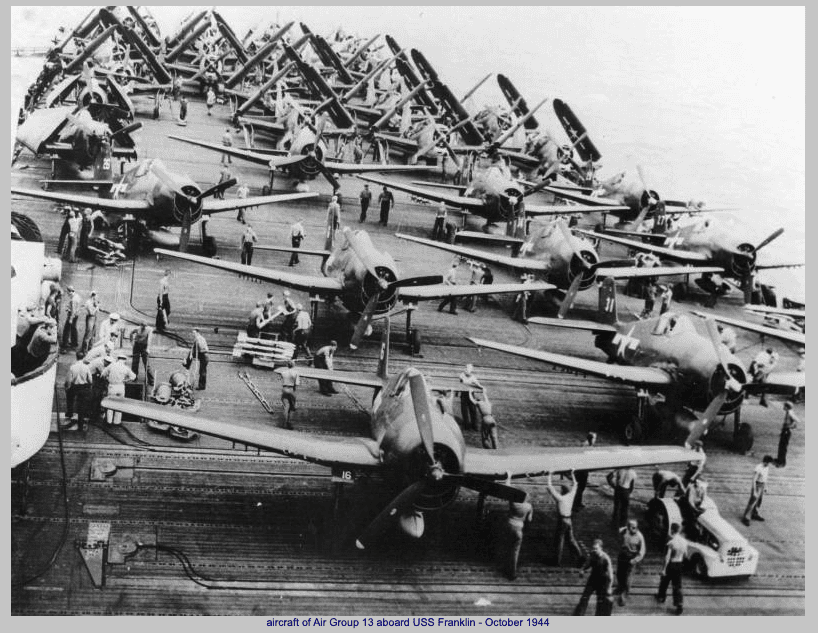USS Franklin Has A Busy October

USS Franklin, part of Task Force 38 under Admiral William Halsey, spent a busy October in 1944 fighting the Japanese in the western Pacific. She’d been flying combat sorties since July 4th with only an occasional break. Iwo Jima and her sisters, along with Guam, Yap, Ulithi, and Peleliu, had all experienced the wrath of Franklin’s Air Squadron Thirteen.
As October drew to a close, the crews of Task Force 38 battled exhaustion from continuous combat sorties, fighting against air attacks and facing a new and terrifying threat—the first Kamikaze attacks.
Lack of sleep was also a significant contributor to exhaustion. Continuous calls to General Quarters to man battle stations disrupted sleep. Aircrews whose sleeping berths were forward under the catapults would be awakened at 4:00 as the first fighters were catapulted off the ship1

Another contributing factor to exhaustion was heat rash. Essex-class ships were not air-conditioned except for certain compartments, such as the Combat Information Center (CIC) and aircrew ready rooms. In the tropics, the heat and humidity combined made it nearly impossible for men below decks to sleep as the compartments quickly overheated. Heat rash was epidemic among the task force, and at times, Franklin had half of her crew on sick report.2
. They still reported back to duty. In his oral history, crew member Robert Tice reported
…but we just put calamine all over, under our arms[sic] and between our legs; it was a mess.3
Last fall, I wrote a series of blog posts on Franklin’s activities in October 1944. Click on each for more information.
Franklin participates in raids on Luzon and Formosa (present-day Taiwan)
10-15 October 1944: USS Franklin Attacks
She supports the Philippines invasion and participates in the Battles of Leyte Gulf.
The Battles Continue: USS Franklin 15-29 October 1944
Fifty-six men would die in a Kamikaze attack that knocked her out of the war for three months.
Kamikazes Attack USS Franklin (CV-13)
And here is a more recent post about the burials at sea conducted the day after the Kamikaze strike.
Burials At Sea by USS Franklin, 1944
Did you arrive here via a search engine? I am the author of the forthcoming book Heroes By The Hundreds: The Story of the USS Franklin (CV-13). In addition to writing about the bravery of the crews that saved her, I will discuss the lessons we can learn in leadership and decision-making and the changes the US Navy made because of those lessons.
Feel free to follow me on Facebook. There, I am M. Glenn Ross, Author. I also write a monthly newsletter, Glenn’s Action Report, about subjects I find interesting in my research. You can sign up for it below. Feel free to leave a comment or ask a question. Thanks for reading.
-Glenn
Footnotes
- Jim Teague Oral History, Interviewed by Ed Metzler. September 19, 2007. Museum of the Pacific War, 23. https://texashistory.unt.edu/ark:/67531/metapth1605271/m2/1/high_res_d/OH02048trs_Teague_Jim.pdf Accessed 26 September 2024
- David Sears, At War With The Wind: The Epic Struggle with Japan’s World War II Suicide Bombers (New York: Kensington Publishing Group, 2009) 157
- Robert Tice Oral History, Interviewed by Robert Misenheimer. December 27, 2005. Museum of the Pacific War, 48 https://texashistory.unt.edu/ark:/67531/metapth1604929/https://texashistory.unt.edu/ark:/67531/metapth1604929/ Accessed 14 August 2024